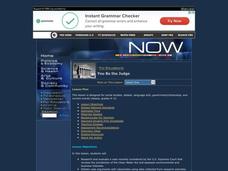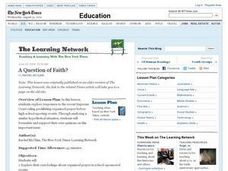Curated OER
A Look At The Current Court
Young scholars examine the characteristics of Supreme Court Justices. Using the interent, they research current effects effecting the Court. They complete a worksheet after examine the biographies of the justices. As a class, they...
Curated OER
You Be the Judge
Students research and evaluate a case considered by the U.S. Supreme Court regarding the jurisdiction of the Clean Water Act. They watch a Bill Moyers video, conduct a debate, and write about the decision they would make if they were a...
Curated OER
Justices for All
Learners examine role of Supreme Court justices in the American political process, research the qualities of the current Supreme Court justices, and write opinion papers evaluating the current justices and recommending future nominations.
Hyperion Publishing
Words We Live By: Your Annotated Guide to the Constitution
The language of the Constitution can feel quite ominous to young learners, but there are a variety of strategies you can utilize to help your class grasp the important concepts and ideals in our nation's founding document. This lesson...
Curated OER
Courts in the Classroom: Ritter v Stanton
Young scholars read the case briefs of Ritter v Stanton. They simulate the trial with classmates taking various parts such as appellant, appellee, bailiff, and justices. After conducting a mock argument, they write their own opinion for...
Curated OER
Just how broken is the Senate?
Twelfth graders examine the role of the Senate in the United States. In this American Government lesson, 12th graders read various articles and answer questions to these articles. Students write a letter to their Senator on a specific...
Curated OER
The My Lai Courts Martial of 1970
Students research the My Lai Massacre and trial. Students discuss the events and the trial, reviewing the constitutional amendments and concerns related to the massacre. Students write an analysis of photographs related to the incident.
Stanford University
Voices of the Struggle: The Continual Struggle for Equality
As part of a study of the Civil Rights Movement from 1868 to the present, class members examine first person narratives, the Supreme Court case Brown v. Board of Education, and other significant events in civil rights history. They then...
Curated OER
You Can Say That Again!
A discussion of the Supreme Court’s Opinion of Tinker v. Des Moines generates a discussion of the Bill of Rights and the First Amendment. Although the key elements of this lesson are based on a video that is not included, the activities...
Curated OER
The Illustrated Bill of Rights
Students shoot Bill of Rights videos. In this Bill of Rights lesson plan, students film digital segment that illustrate the meaning of the first 10 amendments. Students integrate the video clips into PowerPoint presentations.
Alabama Department of Archives and History
Montgomery Bus Boycott: We Would Rather Walk!
Have historians use primary sources to learn about the circumstances and implementation of the Montgomery Bus Boycott, and think about the issue of boycotts as a means of effecting social change. Wrap it up with a letter to the editor...
Curated OER
Making an Appeal
Learners make an appeal. In this making an appeal lesson students give characteristics of the Washington Supreme Court. Learners examine public policy conflicts and present an appellate case.
Curated OER
Supreme Court Confirmation Process
Students examine the Supreme Court and the confirmation process. They simulate a confirmation hearing with students role-playing as nominees and others as members of the Judiciary Committee. Students compose short essays outlining the...
Curated OER
Faces of the Bench
Learners use primary source documents to gather information on justices in the Michigan Supreme Court. They write about the thoughts and experiences of the author. They identify and describe each justice briefly.
Curated OER
Down for the Count?
The New York Times article “Supreme Court, Split 5-4, Halts Florida Count in Blow to Gore” provides the opening to an assessment of the United States Supreme Court decision in the case of the 2000 presidential election. Assuming the...
Curated OER
A Question of Faith?
Should organized prayer be prohibited at high school sporting events? Students explore their own feelings about prayer in school-sponsored events, before discussing the recent Supreme Court decision banning public prayer at high school...
Curated OER
Judicial Review
Students review the concepts they were introduced to in a telecast on judicial review. After reading an article, they answer discussion questions and repeat the same procedure for another article. They participate in a debriefing session...
iCivics
I Can’t Wear What?
Can schools ban t-shirts picturing musical groups or bands? Your young citizens will find out with this resource, which includes a summary of a United States Supreme Court case from the 1960s about a similar dispute over students wearing...
Curated OER
Supreme Court
Eleventh graders explore the redistricting process. In this American Government lesson, 11th graders examine the electoral map. Students write an essay posing an argument for the redistricting process.
Curated OER
First Things First: Using the Newspaper to Teach the Freedoms of the First Amendment
Students use the newspaper as a tool to make connections about what the five freedoms guarantee in the First Amendment. In this first amendment lesson plan, students analyze events in the newspaper to form conclusions about the freedoms...
Smithsonian Institution
Art to Zoo: Life in the Promised Land: African-American Migrants in Northern Cities, 1916-1940
This is a fantastic resource designed for learners to envision what it was like for the three million African-Americans who migrated to urban industrial centers of the northern United States between 1910 and 1940. After reading a...
Curated OER
Role Playing Free Speech
Young scholars conduct research into looking at a free-speech issue. They role play the events surrounding a court case. The lesson includes guiding questions to help create context and determine areas of further study. The presentation...
Curated OER
"Whispering Wires": Public Law vs. Individual Civil Liberties
High school student love discussing controversial issues like those brought up in this fourth amendment case study. They examine the 1928 Olmstead vs. U.S. prohibition court case, applying the fourth amendment to determine whether or not...
Curated OER
Just Say It
Students explore the initial Supreme Court decision to regulate commercial speech, and then analyze the legal precedents and principles underlying a recent case contesting this regulation.

























